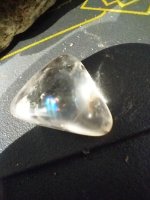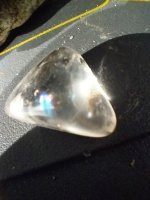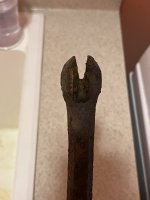Badger Bart
Sr. Member
- Mar 24, 2005
- 301
- 18
Wed Oct 26,12:01 AM ET
JAKARTA (AFP) - In a nondescript warehouse in Jakarta, treasure-hunter Luc Heymans dips into plastic boxes and pulls out jewels and ornaments that lay hidden at the bottom of the Java Sea for 1,000 years.
An ornately sculpted mirror of polished bronze is one masterpiece among the 250,000 artefacts recovered over the last 18 months from a boat that sank off Indonesia's shores in the 10th century.
On a small mould is written the word "Allah" in beautiful Arabic script, on top of a lid sits a delicately chiseled doe.
Tiny perfume flasks accompany jars made of baked clay, while slender-necked vases fill the shelves of the hangar along with brightly colored glassware from the Fatimides dynasty that once ruled ancient Egypt.
A team of divers, among them three Australians, two Britons, three French, three Belgians and two Germans, excavated the vessel laden with rare ceramics which sank more than 1,000 years ago some 130 nautical miles from Jakarta.
Their finds, including artefacts from China's Five Dynasties period from 907 to 960 AD and ancient Egypt, are already causing a stir among archaeologists who say the cargo sheds new light on how ancient merchant routes were forged.
"It is a completely exceptional cargo," says Heymans, the Belgian chief of the excavation team.
"There is very little information about the Five Dynasties era and very few things in the museums. This wreck fills a hole," he tells AFP.
Close to 14,000 pearls and a profusion of precious stones were found in the wreck, including some 4,000 rubies, 400 dark red sapphires, and more than 2,200 garnets.
"On the second last day of diving, I spotted some broken ceramics. Under 30 centimeters of vase, I uncovered the handle of a golden sabre," says Daniel Visnikar, the leading French diver.
It took more than 24,000 dives to recover all the treasure from the boat which rests 54 metres below the surface. Material recovered from the site has whetted the appetite of overseas experts.
"A 10th century wreck is very rare, there are only a few," says Jean-Paul Desroches, a curator at the Guimet Museum in Paris, after seeing photographs of the early hauls.
He says the wreck and its cargo offers clues to how traders using the Silk Road linking China to Europe and the Middle East, used alternative sea routes as China's merchants moved south because of invasions from the north.
The variety of loot pulled from the depths is hard to imagine: dishes adorned with dragons, parakeets and other birds; porcelain with finely-carved edges; teapots decorated with lotus flowers; and celadon plates with their glaze intact.
"These porcelains come from a very special kiln, an imperial kiln, perhaps from the province of Hebei in the north of China," suggests Peter Schwarz, a German ceramics specialist.
Heymans insisted the treasure -- the subject of controversy when the divers were chased from their barge in the open-sea by the Indonesian navy last November -- was stored in a comprehensive and transparent manner.
"Every piece is indexed and we know which part of the boat it comes from. Every week we sent (the Indonesian authorities) a DVD with digital photographs of all the pieces," he says.
As well being chased by the Indonesian navy, an incident that began a long dispute over the booty, Heymans says another group of treasure hunters also tried to move in on the swag.
Cosmix, Heymans' Dubai-based corporation, was the force behind the five-million-euro operation, which was funded by unnamed private investors in Europe.
The divers say the treasures might be bought by a foreign museum or are expected to be shown between 2006 and 2007 in an auction, as the cargo is valued at several million dollars.
Indonesia will receive 50 percent of proceeds from the sale of the treasures.
JAKARTA (AFP) - In a nondescript warehouse in Jakarta, treasure-hunter Luc Heymans dips into plastic boxes and pulls out jewels and ornaments that lay hidden at the bottom of the Java Sea for 1,000 years.
An ornately sculpted mirror of polished bronze is one masterpiece among the 250,000 artefacts recovered over the last 18 months from a boat that sank off Indonesia's shores in the 10th century.
On a small mould is written the word "Allah" in beautiful Arabic script, on top of a lid sits a delicately chiseled doe.
Tiny perfume flasks accompany jars made of baked clay, while slender-necked vases fill the shelves of the hangar along with brightly colored glassware from the Fatimides dynasty that once ruled ancient Egypt.
A team of divers, among them three Australians, two Britons, three French, three Belgians and two Germans, excavated the vessel laden with rare ceramics which sank more than 1,000 years ago some 130 nautical miles from Jakarta.
Their finds, including artefacts from China's Five Dynasties period from 907 to 960 AD and ancient Egypt, are already causing a stir among archaeologists who say the cargo sheds new light on how ancient merchant routes were forged.
"It is a completely exceptional cargo," says Heymans, the Belgian chief of the excavation team.
"There is very little information about the Five Dynasties era and very few things in the museums. This wreck fills a hole," he tells AFP.
Close to 14,000 pearls and a profusion of precious stones were found in the wreck, including some 4,000 rubies, 400 dark red sapphires, and more than 2,200 garnets.
"On the second last day of diving, I spotted some broken ceramics. Under 30 centimeters of vase, I uncovered the handle of a golden sabre," says Daniel Visnikar, the leading French diver.
It took more than 24,000 dives to recover all the treasure from the boat which rests 54 metres below the surface. Material recovered from the site has whetted the appetite of overseas experts.
"A 10th century wreck is very rare, there are only a few," says Jean-Paul Desroches, a curator at the Guimet Museum in Paris, after seeing photographs of the early hauls.
He says the wreck and its cargo offers clues to how traders using the Silk Road linking China to Europe and the Middle East, used alternative sea routes as China's merchants moved south because of invasions from the north.
The variety of loot pulled from the depths is hard to imagine: dishes adorned with dragons, parakeets and other birds; porcelain with finely-carved edges; teapots decorated with lotus flowers; and celadon plates with their glaze intact.
"These porcelains come from a very special kiln, an imperial kiln, perhaps from the province of Hebei in the north of China," suggests Peter Schwarz, a German ceramics specialist.
Heymans insisted the treasure -- the subject of controversy when the divers were chased from their barge in the open-sea by the Indonesian navy last November -- was stored in a comprehensive and transparent manner.
"Every piece is indexed and we know which part of the boat it comes from. Every week we sent (the Indonesian authorities) a DVD with digital photographs of all the pieces," he says.
As well being chased by the Indonesian navy, an incident that began a long dispute over the booty, Heymans says another group of treasure hunters also tried to move in on the swag.
Cosmix, Heymans' Dubai-based corporation, was the force behind the five-million-euro operation, which was funded by unnamed private investors in Europe.
The divers say the treasures might be bought by a foreign museum or are expected to be shown between 2006 and 2007 in an auction, as the cargo is valued at several million dollars.
Indonesia will receive 50 percent of proceeds from the sale of the treasures.







